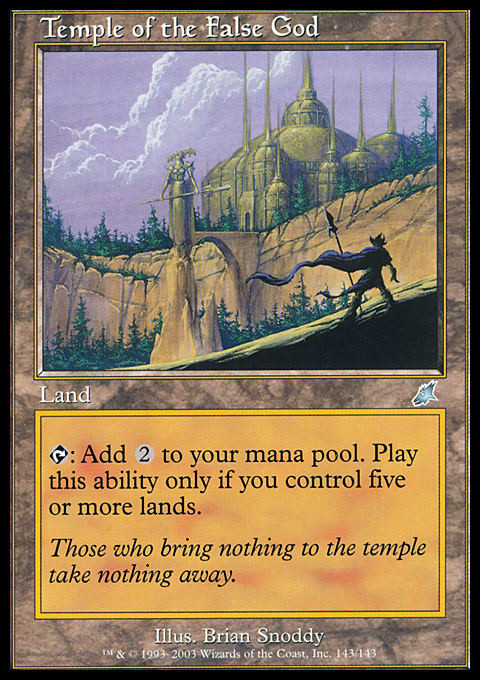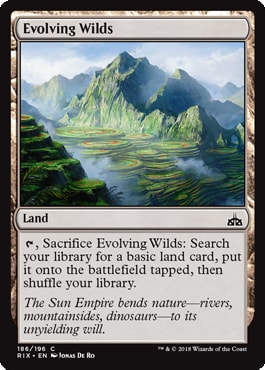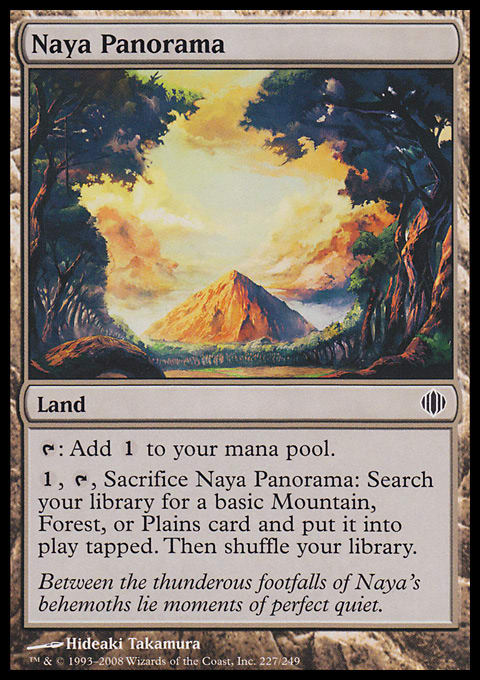Commander is all about enormous monsters, flashy spells, and crazy plays. The important role that lands have to play in building and playing a Commander deck frequently becomes lost among more exciting ideas. As fellow land enthusiasts know, you can build your mana base to do all kinds of awesome things in this format; choosing the best combination of lands to support the creatures and spells you’ve decided to play can make or break a deck.
Lands always contribute passively to your wins. After all, it’s tough to win games in which you can’t cast spells. But is being able to say, “My lands didn’t get in the way of me winning,” really where we want to be? I want you to ask yourself this: Are your lands actively contributing to your wins? If not, they probably could be. We can do better than just jamming a pile of on-color dual lands. Lands can do much, much more.
Fundamentally, lands are there to help us cast spells. But that means different things for different decks. It can mean consistently generating a lot of colors, in which case we’re on the pile-of-duals approach. For my decks, it usually means generating as much mana as possible. You’d be surprised how many ways there are to do that. There’s the obvious nonsense with the likes of Gaea's Cradle and Serra's Sanctum. There’re other options though, particularly for nongreen or nonenchantment decks.
My Kemba, Kha Regent deck makes use of Cloudpost, Temple of the False God, and the Urzatron in conjunction with Vesuva and Thespian's Stage to generate the huge amounts of colorless mana it needs. My Grimgrin, Corpse-Born deck uses Nykthos, Shrine to Nyx and Crypt of Agadeem because it’s easier to generate a ton of black symbols and put creatures in the graveyard. Even my Ephara, God of the Polis deck goes off the wall, combining fetch lands with Surveyor's Scope and Second Sunrise to pull ahead on lands.
There are plenty of ways to try to get things done depending on how much mana your deck needs, how many colors you need, and at what point in the game you need access to it. The key is to pay attention to the small interactions that can add up to a robust, powerful mana base—combinations like fetch lands with Rings of Brighthearth, extra land drops and Karoo lands, or Thawing Glaciers and Deserted Temple. All of these small combos give decks more consistent access to the quantity and type of mana that it may be looking for for very small costs.
It certainly doesn’t hurt that all of these pieces tend to start fitting together. For example, Rings of Brighthearth combos with fetch lands and Thawing Glaciers to help you ensure access to a lot of mana later in the game. Once you’re playing those cards, it’s easy to add Surveyor's Scope and Deserted Temple as virtual Explosive Vegetations. Expedition Map helps find the missing pieces, while cards like Tezzeret the Seeker, Hoarding Dragon, or Wargate could help make the engine more consistent.
The fact that you’re not playing green doesn’t mean you can’t ramp. Especially as we start to see more cards like Myriad Landscape, there are many options available to you as long as you’re willing to put in some work.
Sometimes, it’s not about the quantity of mana, it’s about density. We’ve established that lands are important for casting your spells. There’s nothing more frustrating than losing a game because it’s turn five and you haven’t hit your third land drop yet—except, perhaps, having all the lands in the world and nothing to cast with them. Finding the right land count for your deck is critical to minimizing the frequency of these experiences.
Most of the Commander decks I’ve seen tend to play somewhere around thirty-eight lands. My land counts are notably higher, starting around forty and going up from there. I like hitting land drops and casting my spells. The reason I can run so many and still keep up with more spell-dense decks is that I play a significant number of lands that contribute to my game plan. Lands that double as spells are what make decks consistent. When other players have traded away their haymakers and are left with nothing, you want to be the one with a Gavony Township, Emeria, the Sky Ruin, or Faerie Conclave left over.
These land-based engines can take many different forms. The easiest lands to add are the cycling lands from Onslaught and Urza’s Saga. They’re lands if you need them and second shots at spells if you don’t. There’re plenty of other options though. Buried Ruin is among my favorites. There are plenty of powerful artifacts in Commander, and that Buried Ruin could turn into anything from an Oblivion Stone to a Wurmcoil Engine when the game goes long. In fact, one of my favorite engines in Commander revolves around Petrified Field, Buried Ruin, and Crucible of Worlds. This combination of cards gives your Buried Ruin redundancy. Buried Ruin can grab Crucible, Petrified Field can grab Buried Ruin, and you can always keep your value engine on the table.
There are other options similar to Buried Ruin. Haunted Fengraf is quite reasonable now that we have delve spells to clear up the graveyard. Hideaway lands, Kessig Wolf Run, and Vault of the Archangel are all powerful tools that ensure you always have something to do with your mana.
Let’s look at a few examples.
There are a lot of ways to build and play Oloro, Ageless Ascetic. The two consistent themes are that you’re going to be gaining a lot of life and drawing a lot of cards. That means hitting a lot of land drops, so gaining extra value out of those extra lands is going to be a good thing. It turns out that there are a lot of lands that gain life. Those lands turn into cantrips with Oloro in play, and you can double up on them with Dimir Aqueduct and other Ravnica bounce lands. Here’s what that mana base might start to look like:
Oloro Mana Base
- Lands (18)
- 1 Jwar Isle Refuge
- 1 Sejiri Refuge
- 1 Dismal Backwater
- 1 Tranquil Cove
- 1 Scoured Barrens
- 1 Kabira Crossroads
- 1 Glimmerpost
- 1 Radiant Fountain
- 1 Seraph Sanctuary
- 1 Vesuva
- 1 Dimir Aqueduct
- 1 Azorius Chancery
- 1 Orzhov Basilica
- 1 Vault of the Archangel
- 1 Springjack Pasture
- 1 High Market
- 1 Nomad Stadium
- 1 Orzhova, the Church of Deals
Suddenly, you can string together turns in which your lands cantrip into more life-gain and bombs. Some of these might be a little expensive—I’m looking at you, Springjack Pasture and Orzhova, the Church of Deals—but that will become apparent pretty quickly. The untapped life-gain lands are basically free; they pay for their own cantrip off Oloro. Other effects, such as High Market and Seraph Sanctuary, let you consistently draw cards off them if your deck is built around it.
Alternatively, we can look at my Prime Speaker Zegana deck. This is a deck that wants to hit a lot of land drops, generate a lot of mana, and make Zegana as enormous as possible. Lands are the simplest and most consistent ways to enable that. Let’s take a look:
Prime Speaker Zegana Mana Base
Once again, we’re looking at small edges that add up. There are a lot of ways to give Zegana an extra +1/+1 every time you cast her. Making copies of Oran-Rief, the Vastwood is absurdly powerful since each copy is an extra card. Similarly, Opal Palace grows increasingly busted as the games go longer and you cast Zegana additional times. These lands serve to make your commander more consistently powerful, and they really make the difference when games don’t go exactly according to plan.
There’s one more new and exciting example I want to look at that pushes the importance of your mana to a new extreme. Let’s look at Titania, Protector of Argoth.
First and foremost, this card is super-busted. It may just be the new green staple. I can’t think of a single green deck I’ve ever built that doesn’t want access to this card. All it takes is one fetch land sometime before turn five, and you have a ramp spell with 10 power attached. Not only that, but it also recurs all of your powerful lands such as Gaea's Cradle and Emeria, the Sky Ruin. What do you mean the ramp deck wins if you cast Armageddon? Are you kidding!?
Titania raises an interesting question regarding fetch lands. Now, I’m already a big proponent of fetch lands, even in mono-colored decks or ones without shock lands. Between Sensei's Divining Top, Scroll Rack, and Surveyor's Scope, there’re plenty of reasons to play fetches in nongreen decks. Green decks have all manner of additional incentives, such as Oracle of Mul Daya, Courser of Kruphix, and now Titania, Protector of Argoth.
But how many fetch lands can the average Commander deck play? If budget’s no issue, you have ten allied and enemy fetches from Zendikar and Onslaught. Khans of Tarkir has even made the allied fetches infinitely more accessible than they used to be. If those are outside your budget, it’s pretty easy to play Evolving Wilds and Terramorphic Expanse as a starting point. The Panorama cycle from Shards of Alara is pretty reasonable, and the Mirage fetch lands like Flood Plain are perfectly defensible as well. We can go even deeper for something like Terminal Moraine, but I doubt that’s really necessary.
What I want to know is just how powerful your mana base can be when it’s making instant-speed 5/3 Elementals instead of drawing a few cards here and there. The backbone of the deck is clearly fetch lands, but how deep can we go? Tectonic Edges and Petrified Fields are good places to start, but it’s possible we even want cards like Archaeological Dig and Timberland Ruins
Titania can even team up with Crop Rotation and Life from the Loam to find the few lands that do power up this strategy, such as Oran-Rief, the Vastwood as well as Deserted Temple, Vesuva, and Thespian's Stage. These help to make sure your Elementals keep pace with the size of your opponents’ threats as the game goes late. Add in Garruk's Packleader, Kavu Lair, and Regal Force, and suddenly, you have a cantripping army of Elementals.
With these ideas in mind, here’s where I’m starting with Titania:
Titania Midrange ? Commander | Carlos Gutierrez
- Commander (0)
- Lands (49)
- 1 Buried Ruin
- 1 Haunted Fengraf
- 1 Petrified Field
- 1 Oran-Rief, the Vastwood
- 1 Vesuva
- 1 Deserted Temple
- 1 Thespian's Stage
- 1 High Market
- 1 Miren, the Moaning Well
- 1 Dryad Arbor
- 1 Tectonic Edge
- 1 Strip Mine
- 1 Phyrexia's Core
- 1 Archaeological Dig
- 1 Evolving Wilds
- 1 Terramorphic Expanse
- 1 Mountain Valley
- 1 Grasslands
- 1 Wooded Foothills
- 1 Windswept Heath
- 1 Verdant Catacomb
- 1 Misty Rainforest
- 1 Jund Panorama
- 1 Naya Panorama
- 1 Bant Panorama
- 1 Terminal Moraine
- 1 Gaea's Cradle
- 1 Darksteel Citadel
- 1 Tree of Tales
- 20 Snow-Covered Forest
- Creatures (19)
- 1 Kamahl, Fist of Krosa
- 1 Tribal Forcemage
- 1 Eternal Witness
- 1 Woodfall Primus
- 1 Regal Force
- 1 Rampaging Baloths
- 1 Avenger of Zendikar
- 1 Fierce Empath
- 1 Stone-Seeder Hierophant
- 1 Magus of the Candelabra
- 1 Reclamation Sage
- 1 Soul of New Phyrexia
- 1 Oracle of Mul Daya
- 1 Garruk's Packleader
- 1 Nessian Game Warden
- 1 Tilling Treefolk
- 1 Nantuko Cultivator
- 1 Genesis Hydra
- 1 Scavenging Ooze
- Spells (16)
- 1 Renewal
- 1 Harrow
- 1 Crop Rotation
- 1 Scapeshift
- 1 Momentous Fall
- 1 Life's Legacy
- 1 Garruk, Primal Hunter
- 1 Chord of Calling
- 1 Realms Uncharted
- 1 Green Sun's Zenith
- 1 Woodland Guidance
- 1 Natural Order
- 1 Life from the Loam
- 1 Setessan Tactics
- 1 Summer Bloom
- 1 Genesis Wave
- Artifacts and Enchantments (15)
- 1 Trading Post
- 1 Nim Deathmantle
- 1 Muraganda Petroglyphs
- 1 Crucible of Worlds
- 1 Konda's Banner
- 1 Darksteel Plate
- 1 Spine of Ish Sah
- 1 Obelisk of Urd
- 1 Coat of Arms
- 1 Garruk Wildspeaker
- 1 Sylvan Library
- 1 Beastmaster Ascension
- 1 Greater Good
- 1 Kavu Lair
- 1 Expedition Map
It has maximum fetch lands and maximum Oran-Rief action. There are a lot of artifact interactions to go with Buried Ruin. The game plan is basically to go all-in on Titania interactions to find out just how good the card is and whether it’s powerful enough to support a deck all on its own. Chord of Calling and the like give you access to plenty of utility creatures when you need them. Woodfall Primus in particular is super-powerful given the deck’s focus on Oran-Rief shenanigans and sacrifice outlets.
I don’t know what the ideal mana base for Titania is going to end up looking like. I’m sure there will be significant variation depending on what exactly the lists are trying to do, but it’s really interesting to see where some of these choices come from. Buried Ruin can be rebuying Obelisk of Urd in an aggressive build or Nevinyrral's Disk in a controlling build. Either way, Titania returns your Buried Ruin and makes more 5/3s.
We’re only just scratching the surface on Titania. She has an incredibly powerful combination of abilities, and I’m positively giddy at seeing what the community ends up doing with her.
Whispers of the Muse
- Karametra, God of Harvests, Titania, and Faith's Reward seems like a wombo combo with Zuran Orb.
- Consider Junk Enchantress with Mesa Enchantress, Doomwake Giant, and the usual suspects. Karador, Ghost Chieftain keeps Enchantresses on the table!





























